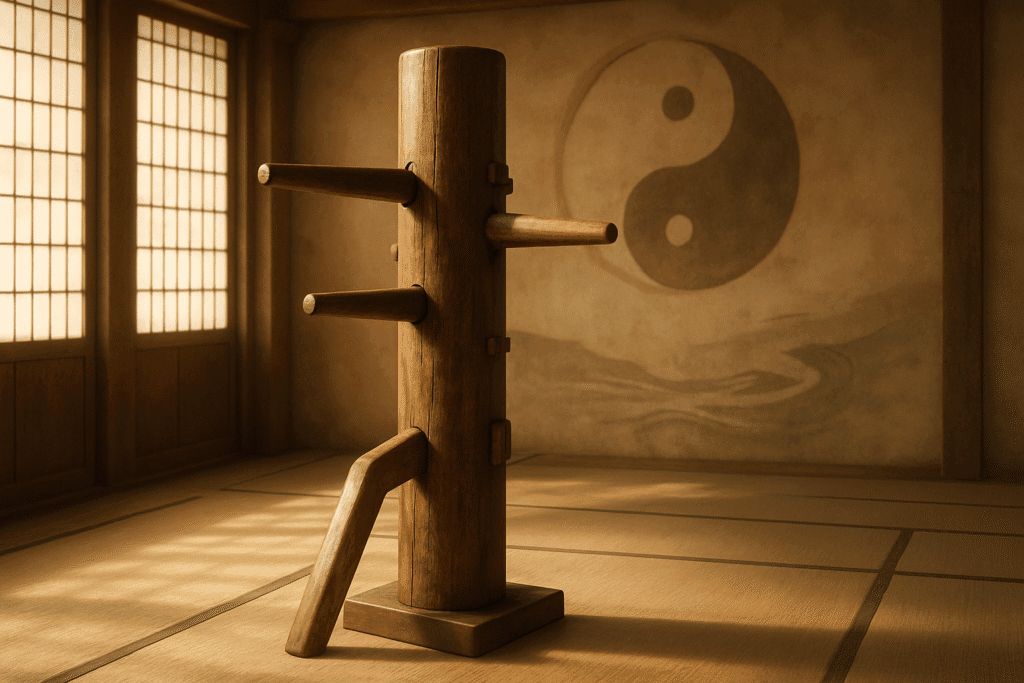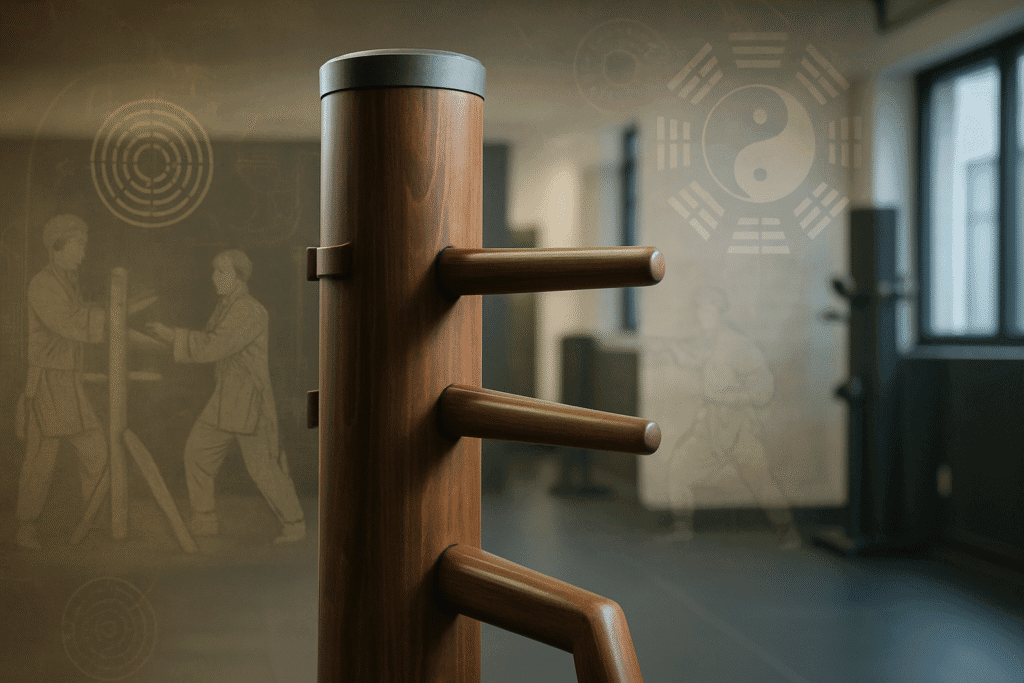Hey there, fellow martial arts enthusiasts and seekers of deeper meaning!
Today, I want to share something truly special with you –
a journey into the heart of Wing Chun, specifically focusing on its iconic training tool:
the Wooden Dummy, or Mook Yan Jong. You might see it as just a piece of wood with arms and a leg, but trust me, it’s so much more than that.
It’s a silent teacher, a philosophical guide, and a mirror reflecting your own growth.
I’ve always been fascinated by how martial arts intertwine with philosophy.
It’s not just about learning to defend yourself; it’s about understanding yourself, your reactions, and the principles that govern effective movement and thought.
The wooden dummy, in my experience, is one of the most profound tools for this kind of self-discovery.
It pushes you, challenges you, and in doing so, reveals layers of understanding you never knew existed.

Videos are added as random thoughts 💭 💭 🤔 🤔 🤔..
So, let’s dive deep into the philosophical underpinnings of this incredible training partner.
We’ll explore how it helps us simulate opponents, cultivate mental discipline, find balance, and ultimately, bridge the gap between theory and real-world application.
Get ready to see the Mook Yan Jong in a whole new light!
The Silent Opponent: Simulating Reality
One of the most immediate and practical philosophical aspects of the wooden dummy is its role as a simulated opponent.
It’s not a living, breathing person, but that’s precisely its strength.
The Mook Yan Jong allows you to practice techniques, angles, and distances without the unpredictable variables of a human partner.
It’s a controlled environment where you can make mistakes, learn, and refine your movements without fear of injuring yourself or others.
I remember countless hours spent on the dummy, trying to perfect a simple pak sau or a lap sau.
At first, it felt awkward, almost robotic.
But as I continued, the dummy started to feel less like a static object and more like a dynamic force.
It taught me about the importance of proper structure and how to absorb and redirect force.
It became my tireless training partner, always there, always ready to help me improve.
This consistent, unwavering presence is key to developing muscle memory and instinctive reactions.
This simulation isn’t just about physical contact; it’s about understanding the flow of combat.
The dummy’s fixed limbs represent an opponent’s arms and legs, allowing you to practice interception and control.
It’s about learning to blend offense and defense seamlessly, a core principle of Wing Chun.
The insights gained here are invaluable, translating directly to how you might react in a real-world scenario.
It’s a safe space to explore the complexities of combat, one precise movement at a time
Cultivating Inner Strength: Mental Discipline and Resilience
Beyond the physical, the wooden dummy is a profound tool for cultivating mental discipline and resilience.
Training with it demands focus, patience, and an unwavering commitment to repetition.
There are no shortcuts on the Mook Yan Jong.
You can’t rush the process, and you can’t cheat the feedback it provides.
I’ve had days where I felt frustrated, where my movements felt clunky, and progress seemed elusive.
But it’s precisely in those moments of struggle that the dummy teaches its most valuable lessons.
It forces you to confront your imperfections, to push through discomfort, and to maintain a calm mind even when things aren’t going perfectly.
This mental fortitude, this ability to persevere and stay present, is a direct result of consistent wooden dummy practice.
This isn’t just about enduring physical strain; it’s about building mental toughness that extends far beyond the training hall.
The discipline you develop in meticulously repeating movements, correcting errors, and staying focused translates into other areas of your life.
It teaches you the value of incremental progress and the importance of a resilient mindset when facing challenges.
It’s a quiet, internal battle that ultimately strengthens your character.
The Dance of Balance and Harmony: Yin and Yang in Motion
At the heart of Wing Chun philosophy, and deeply embedded in wooden dummy practice, is the concept of Yin and Yang –
the interplay of opposing yet complementary forces.
The Mook Yan Jong embodies this duality, teaching you to find balance in every movement, every strike, and every defense.
It’s about understanding how hard meets soft, how yielding creates opportunity, and how attack and defense are not separate but intertwined.
When I train on the dummy, I’m constantly reminded of this principle.
Sometimes I need to apply firm, direct force, while at other times, a subtle redirection or yielding is far more effective.
The dummy, with its unyielding structure, forces you to adapt, to flow like water around an obstacle rather than crashing against it.
This constant negotiation between force and fluidity, between directness and adaptability, is the essence of Wing Chun and a profound life lesson.
This philosophical dance extends to your own body mechanics.
The wooden dummy helps you understand how to maintain your center, how to root yourself, and how to generate power efficiently while remaining balanced.
It’s a continuous lesson in equilibrium, not just physically, but mentally and emotionally.
It teaches you that true strength lies not in rigidity, but in the ability to adapt and harmonize with whatever comes your way.
Foundation for Growth: Building a Solid Base
The wooden dummy is often considered the culmination of Wing Chun training, but it’s also a foundational tool.
The drills performed on the Mook Yan Jong are designed to internalize the core principles of the art,
developing proper body mechanics and creating muscle memory that forms the bedrock for all other techniques.
It’s like building a house – you need a strong foundation before you can add the walls and roof.
I’ve found that returning to the basic wooden dummy forms, even after years of practice, always reveals something new.
It’s a constant refinement process.
Each repetition deepens your understanding of how your body should move, how force is generated and transmitted, and how to maintain structural integrity.
This continuous reinforcement of fundamentals is what allows for true growth and mastery in Wing Chun.
This aspect of the dummy practice reminds me that true mastery isn’t about flashy techniques, but about a deep understanding and consistent application of the basics.
It’s about building a robust internal framework that supports all your actions, both in martial arts and in life.
The dummy is an honest teacher, always pointing you back to the essentials, ensuring your growth is built on solid ground.
Bridging Forms to Application: From Theory to Reality
Wing Chun forms are like a language, and the wooden dummy is where you learn to speak it fluently.
The Mook Yan Jong acts as a crucial bridge between the theoretical movements learned in the solo forms (Siu Lim Tao, Chum Kiu, Biu Jee) and their practical application in a dynamic, combat-like scenario.
It’s where abstract concepts become tangible skills.
I’ve often heard practitioners say that without the wooden dummy, the forms remain just that – forms.
The dummy provides the resistance, the angles, and the structure that allows you to truly understand the intent behind each movement.
It helps you translate the flow of a form into effective offensive and defensive actions.
It’s the missing link that connects the intellectual understanding of Wing Chun to its physical manifestation.
This bridging function is perhaps one of the most vital philosophical contributions of the wooden dummy.
It teaches you that knowledge without application is incomplete.
It pushes you to move beyond rote memorization and into a realm of true understanding and adaptability.
It’s about making the art alive, practical, and deeply personal.
More Than Just Wood: A Path to Self-Mastery
As you can see, the Wing Chun wooden dummy is far more than a simple training apparatus.
It’s a profound philosophical tool that guides practitioners toward self-mastery, both physically and mentally.
It teaches us about adaptability, resilience, balance, and the critical connection between theory and application.
Every strike, every block, every movement on the Mook Yan Jong is a lesson in life itself.
If you’ve ever had the chance to train with a wooden dummy, you know the unique connection you develop with it.
If not, I hope this post has given you a new appreciation for this incredible piece of martial arts history and philosophy.
It’s a journey of continuous learning, and the wooden dummy is a steadfast companion on that path.
What are your thoughts on the philosophical aspects of martial arts training?
Have you had any profound experiences with the wooden dummy or other training tools?
Share your insights in the comments below! Let’s keep this conversation going.



